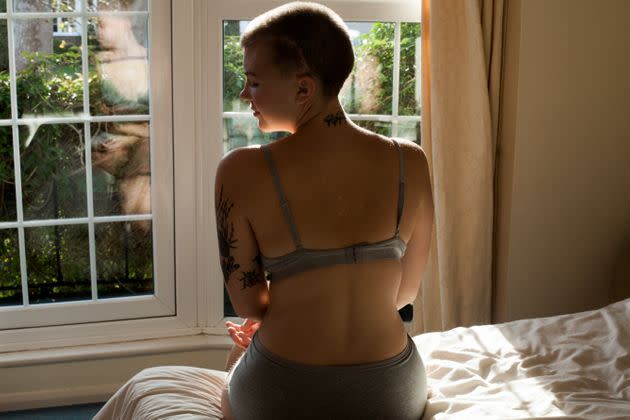The Rhythm Method Is All Over TikTok. Here's What Women Need To Know

(Photo: Sophie Mayanne via Getty Images)
Some call it the rhythm method, others talk about natural family planning, fertility awareness or natural contraception.
Whatever name you know it by, it’s having a major moment on TikTok. Videos about the “rhythm method” have gained a staggering 905 million views on the platform, while videos about “natural family planning” have reached 61 million.
The actual content of these clips varies wildly – no surprise, given the sheer volume of them. You’ll find self-proclaimed “fertility coaches” and “period experts” detailing the benefits, alongside women claiming life is better off without the pill. There’s also those sounding a warning that, as contraception, it’s a “terrible idea”, and the odd healthcare professional trying to wade through the noise and deliver nuance – not easy, in snackable, two minute form.
For her part, Annabel Sowemimo, a sexual and reproductive health doctor and founder of the community interest group Decolonising Contraception, thinks it’s a positive thing that people are discussing these topics on social media, because, ultimately, it helps to break down “barriers of marginalisation and inequality in sexual and reproductive healthcare”.
But be careful about following advice from those unqualified to give it, Dr Sowemimo says, because there’s also “a lot of misinformation”.
So, what is natural family planning?
In a nutshell, natural family planning (NFP) involves monitoring and recording different fertility signals during your menstrual cycle to work out when you’re most likely to get pregnant.
While some people use these methods because they want to become a parent, others (including many of those posting on TikTok) advocate this as a method of medical-free contraception.
“It’s using what we call fertility indicators,” Dr Sowemimo explains. “So certain bits of body physiology, plus your menstrual cycle calendar, to work out your fertility window.”
Fertility indicators can include temperature monitoring (your temperature usually goes up slightly when you’re ovulating), cervical secretions (aka discharge, which changes through the stages of your cycle), and tracking your symptoms using a calendar.
“Usually, this is a method that people can use if they have regular cycles and they have been off hormonal contraception for at least kind of a couple of cycles, so they know that that’s their regular period,” Dr Sowemimo says.
Those using NFP might abstain from sex during their fertile window or double up using another method of contraception, such as condoms.
Why this growing interest in the rhythm method?
Well, there are a range of apps available now, making fertility tracking easier to complete via your phone. A 2019 survey from Natural Cycles – one of the most popular – found that 36% of UK women surveyed said they’re avoiding other forms of contraception because they’re opposed to taking hormones.
The reasons for this are complex. Yes, the pill was widely heralded as the gateway to women’s sexual liberation. But there’s no denying it has also cemented contraception as a woman’s responsibility.
Dr Sowemimo says people are intrigued by NFP, thinking it presents an escape from the “shackles” of the contraceptive burden. But don’t be fooled – checking your temperature and discharge and logging your symptoms on an app daily is actually far more labour intensive than popping a pill each morning – or night.

(Photo: Sophie Mayanne via Getty Images)
Apps like Natural Cycles, which launched in 2013, are nothing new. The market leader was told to stop advertising itself as “a highly accurate method of contraception” in the UK in 2018, though it is FDA-approved in the US. So why the sudden TikTok interest?
Dr Sowemimo says it’s understandable that more people are curious about natural family planning in current political and social contexts.
“In the US, you’ve had this uptick in fears around birth control access, because of Roe v. Wade overturning,” she explains. “So people are like, ‘Well, if I use something which isn’t medicalised, then there’s not that worry of not been able to get access to that method, if laws or legislation changes.’”
There are also concerns around contraception access in the UK. Under the newly-released Women’s Health Strategy and the Sexual Reproductive Health Strategy, policy makers say they’re addressing how contraception is commissioned across the country – because the current system is not working.
There’s “a lot of issues with access and structure and funding,” says Dr Sowemimo.
GP appointments are hard to come by. Nearly half of respondents (47%) in the most recent GP Patient Survey said it was not easy to get through to their GP practice on the phone. In some areas, GP surgeries are only accepting appointments for “medial emergencies”, due to staff shortages.
Besides, not all GP clinics are set up for fitting long active contraceptives, such as the coil (also called an IUD).
“What this means is, that people are constantly having to take their pants off multiple times to be examined, when they probably could do everything, like have their smear and their IUD fitted, all in one go,” says Dr Sowemimo.
Co-ordinating multiple appointments takes time and travelling to these appointments costs money. Both barriers are likely to hit women on low incomes, parents and those juggling multiple jobs the hardest.
Dr Sowemimo says she’s heard of patients having to wait months to have IUDs fitted or removed if they later experience side effects.
“It is really unacceptable,” she says. “There are people going out of their areas [for treatment]. And I’ve had people tell me that they’ve attempted removal themselves. People have tried to pull out IUDs in the bath and stuff like that.
“If you look at a video online, people might think it’s really straightforward. But if it gets stuck, it could be an absolute nightmare.”
Without confidence they’ll have access to a healthcare professional for contraceptive prescriptions or removal, some women are leaning towards the rhythm method to maintain “body autonomy”, she adds.
Dr Sowemimo has also noticed people leaning towards natural methods in order to abide by a vegan lifestyle. (Did you know that lactose, which derives from cow’s milk, is present in all currently available contraceptive pills in the UK?)
Is natural family planning a good idea, then?
There isn’t a black and white answer to this. For those who can’t access other forms of contraception or don’t want to because of the issues outlined above, fertility tracking may be a better option than, say, crossing your fingers and hoping for the best. But it’s certainly not fail-safe.
How accurate the method is varies highly, depending on the individual person and how you conduct your fertility tracking.

(Photo: Ashley Armitage / Refinery29 for Getty Images via Getty Images)
“We always talk about ‘typical’ use and ‘perfect’ use,” Dr Sowemimo explains. “So with perfect use, you’d get around one pregnancy out of 100 with fertility awareness method. When it’s not perfect use, it’s about 24 in 100 pregnancies– and that’s for average use.”
Even with the utmost dedication, interpreting your fertility tracking results can be confusing.
Your temperature can change for other reasons unrelated to ovulation, potentially skewing results. “If you are unwell, or if you’ve been drinking alcohol, your temperature can change,” says Dr Sowemimo.
“And we’re talking about point something of a degree that we’re looking for in terms of signifiers of ovulation, it is a very subtle temperature change.”
Cervical secretions can also be tricksy to monitor consistently. “Some people have mucus throughout the whole cycle, it just changes slightly, and some people never have any mucus, it’s very, very dry. So what they’re looking for is very, very subtle.”
“I always say ‘how not-pregnant do you want to be?’”Dr Annabel Sowemimo
Some of the leading apps that advocate for this method say it’s as reliable as the combined contraceptive pill – or even slightly better. But Dr Sowemimo warns that trials are usually conducted by companies with a vested interest and there’s yet to be wide-scale, independent, impartial analysis.
This method may also be unsuitable for those with underlying conditions.
“If you have other conditions like polycystic ovaries, which throw your cycle off and you won’t have periods for ages, you’re not going to know when you’re ovulating, or ovulation isn’t regular, so this method is not going to be reliable for you,” Dr Sowemimo says.
Whatever contraception method you’re considering, Dr Sowemimo believes you should look at the associated risks and ask yourself: “How much would pregnancy bother you?”
“I always say ‘how not-pregnant do you want to be?’” she says. “If you want to use [NFP] and if you got pregnant, and it wouldn’t be so much of an issue, then that’s cool.
“Also, you need to be aware of how you feel about abortion. If having an abortion would make you really traumatised – which for some people, it would – then this is probably not the right method for you.”
This article originally appeared on HuffPost UK and has been updated.

 Yahoo Movies
Yahoo Movies 